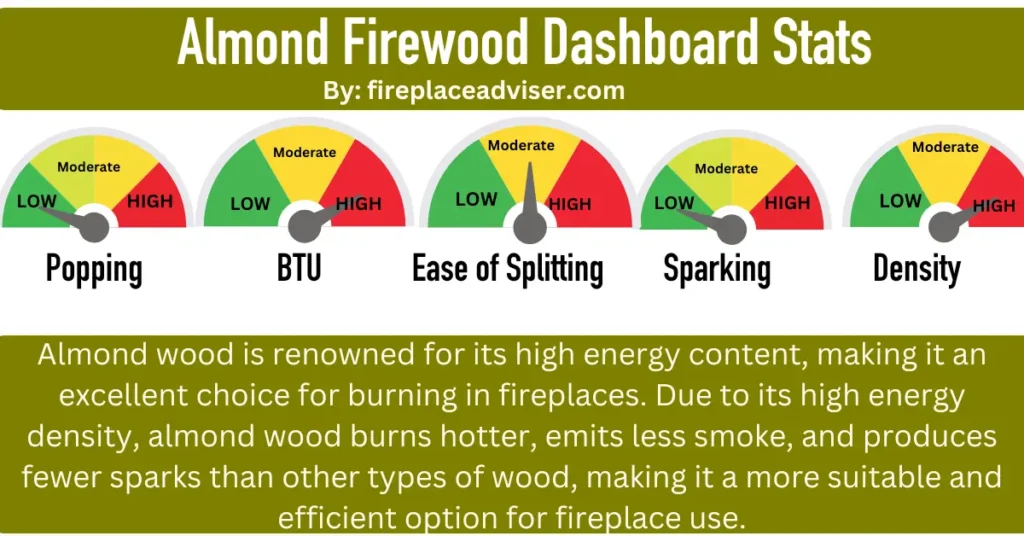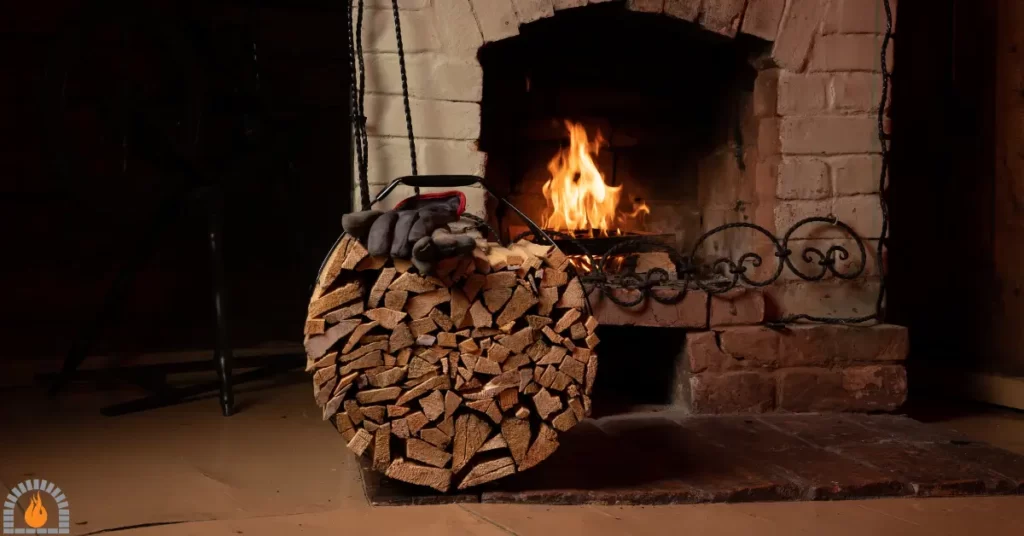When choosing firewood for your fireplace, you might wonder which type is best. One lesser known but increasingly popular option is almond wood.
Question: Is Almond Wood Good for Your Fireplace?
Answer: Yes, almond wood is renowned for its high energy content, making it an excellent choice for burning in fireplaces. Due to its high energy density, almond wood burns hotter, emits less smoke, and produces fewer sparks than other types of wood, making it a more suitable and efficient option for fireplace use.
| Almond Firewood Characteristic | Description |
|---|---|
| BTU (British Thermal Unit) | High – Almond firewood provides approximately 32.9 million BTUs per cord. |
| Nature of Smoking | Low – Produces minimal smoke when properly seasoned. |
| Nature of Popping | Low to Moderate – Occasional popping, making it relatively safe for indoor use. |
| Nature of Sparking | Low – Rarely sparks, which makes it a good choice for indoor fireplaces. |
| Ease of Seasoning | Moderate – Takes about 6 to 12 months to season properly, depending on the climate. |
| Ease of Splitting | Moderate – Requires some effort to split, but generally splits well with proper tools. |
| Moisture Content | Low when seasoned – Should be seasoned to below 20% moisture content for optimal burning. |
| Burning Characteristics | Long burn time and produces a steady, hot fire. |
| Ash Production | Low – Produces a minimal amount of ash, making cleanup easier. |
| Aroma | Pleasant, mild aroma – Adds a nice fragrance to the burning experience. |
| Availability | Common in regions where almond trees are grown, less common elsewhere. |
| Overall | Excellent for heating and cooking, offering high heat output and a pleasant burning experience. |
In this comprehensive guide, we’ll explore the characteristics of almond firewood, its burning properties, its environmental impact, and whether it’s a suitable choice for your fireplace.
Is Almond Wood Good for Your Fireplace?
Almond wood is considered to be good for your fireplace. Almond wood is a popular choice for firewood due to its several positive qualities. Here are some reasons why almond wood is a good option:
- Almond firewood is known to have a high energy content, which means it burns hotter and longer than other types of firewood. This can help keep your fireplace warm and cozy for an extended period.
- When burned, almond wood produces a pleasant, sweet aroma that can enhance the ambiance of your home during the colder months.
- Almond wood produces less smoke and fewer sparks than other hardwoods, making it a safer and cleaner option for indoor use.
- Properly seasoned almond wood burns more efficiently and emits less creosote, reducing the risk of chimney fires and keeping your fireplace and chimney in better condition.
- Almond firewood is renewable since almond trees are cultivated for their nuts. Choosing almond wood for your fireplace can be more environmentally friendly than using non-renewable fossil fuels for heating.

Almond Wood Characteristics For Fireplace Burning
Dense and Efficient Burning
One of the key reasons why almond wood is favored for fireplaces is its density. Almond wood is denser than other firewood types, such as oak or maple.
This density allows it to burn longer and produce more heat, making it an efficient option for heating your home during chilly nights.

Pleasant Aroma and Minimal Smoke
Another attractive feature of almond wood is its pleasant aroma when burned. Unlike some other woods that can emit harsh or pungent odors, almond wood produces a mild and sweet fragrance that enhances the overall ambiance of your living space.
The wood produces minimal smoke when properly seasoned, reducing the risk of indoor air pollution.
Low Ash Residue
Using almond wood as firewood in your fireplace means less cleanup. It produces relatively low amounts of ash compared to softer woods, saving you time and effort in maintaining your fireplace.
Pros & Cons of Almond as Buring Wood
Pros:
- High Energy Content
- Pleasant Aroma
- Low Smoke
- Easy to Ignite
- Long-Lasting Burn
Cons:
- Costly
- Limited Availability
- Hardness
- Air Quality Concerns
- Sustainability
- Ash Residue
Importance of Seasoning Almond Wood
For optimal burning and efficiency, it’s essential to season almond wood properly. Seasoning involves drying the wood to reduce its moisture content.
Freshly cut almond wood typically has a high moisture level, which can lead to poor combustion and excess smoke. Properly dried almond wood should have a moisture content of around 15-20% for optimal burning performance.
Tips for Storing Almond Wood
Proper storage is essential to maximize almond wood’s benefits.
Keep the wood off the ground to prevent moisture absorption and cover it with a tarp or firewood cover to shield it from rain and snow. This ensures that the wood remains dry and ready for efficient burning.

Read More:
FAQs
What kind of wood should not be burned in a fireplace?
- Treated or painted wood, as it releases toxic fumes.
- Softwoods like pine, as they can produce excessive creosote buildup.
Is almond wood a hard or soft wood?
Almond wood is a hardwood.
Is Almond Wood smoke a lot?
No, almond wood generally produces moderate smoke.
Is Almond Wood spark a lot?
No, almond wood tends to produce few sparks.
My Final Thoughts: Is Almond Wood Good for Your Fireplace?
In conclusion, almond firewood can indeed be an excellent choice for your fireplace. Its dense and efficient burning properties, pleasant aroma, low ash residue, and eco-friendliness make it a compelling option. However, remember to properly season the wood and ensure your fireplace is compatible with hardwoods before use.
Following these guidelines, you can enjoy cozy nights by the fire with the warmth and charm that almond wood brings to your home.
Affiliate Disclosure: Fireplaceadviser.com is a participant in the Amazon Services LLC Associates Program. We may earn a commission when you click on certain links on this site and purchase.

Hello!! I am Jamal Khan. I often fix my home electric heaters and gas stove problems and research the common issues in the heating units to improve my knowledge and expertise. The aim of establishing fireplaceadviser.com is to share my expertise and knowledge with my audience.











